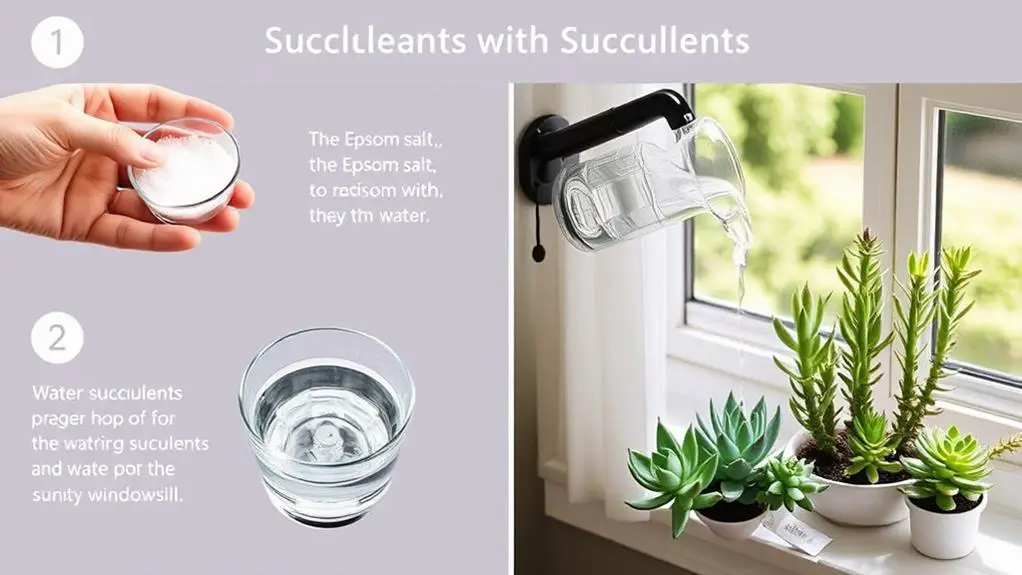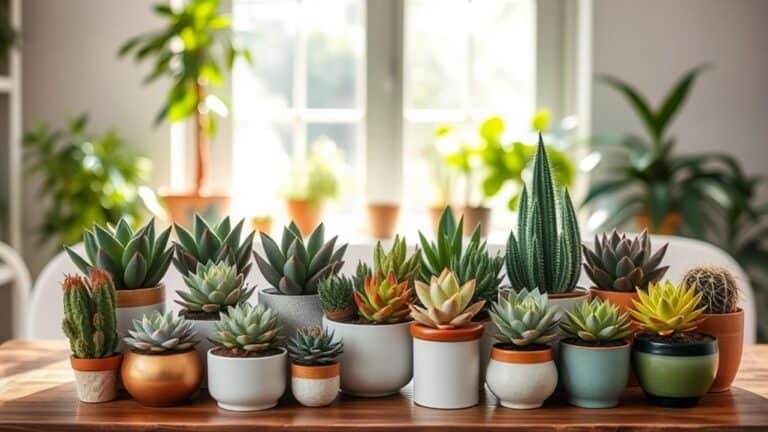10 Steps to Use Epsom Salt With Your Succulents
If you're looking to boost the health of your succulents, incorporating Epsom salt might just be the solution you need. Understanding the benefits and knowing how to properly apply it can make a significant difference in your plants' vitality. Before you start, it's important to test your soil's magnesium levels and pH. Once you have that information, you'll be ready to prepare a beneficial solution and apply it correctly. Curious about the exact steps and how often you should use it? Let's walk through each detail to guarantee your succulents thrive.
Understand Epsom Salt

While you might think Epsom salt is just another household item, it's actually a powerhouse for your succulent garden. Composed of magnesium sulfate, Epsom salt provides essential nutrients that your succulents need to thrive.
The magnesium component aids in chlorophyll production, which enhances photosynthesis and leads to vibrant leaf color. This keeps your succulents looking lush and healthy.
Additionally, the sulfate in Epsom salt helps your plants absorb other essential elements like nitrogen, phosphorus, and potassium more effectively. This combination supports overall plant health and growth.
Know the Benefits

To truly appreciate the benefits of Epsom salt for your succulents, you need to understand its multifaceted impact. Epsom salt, made of magnesium sulfate, boosts chlorophyll production, which is essential for healthy photosynthesis and growth.
Regular use helps your succulents absorb nutrients like phosphorus, nitrogen, and potassium better, ensuring vibrant health. The magnesium strengthens cell walls, making your plants more resistant to pests and diseases, enhancing succulents' health.
You'll notice improved leaf coloration and more blooms, making your plants more attractive. Additionally, Epsom salt prevents magnesium deficiency, which can cause yellowing leaves and stunted growth.
Test Soil Magnesium
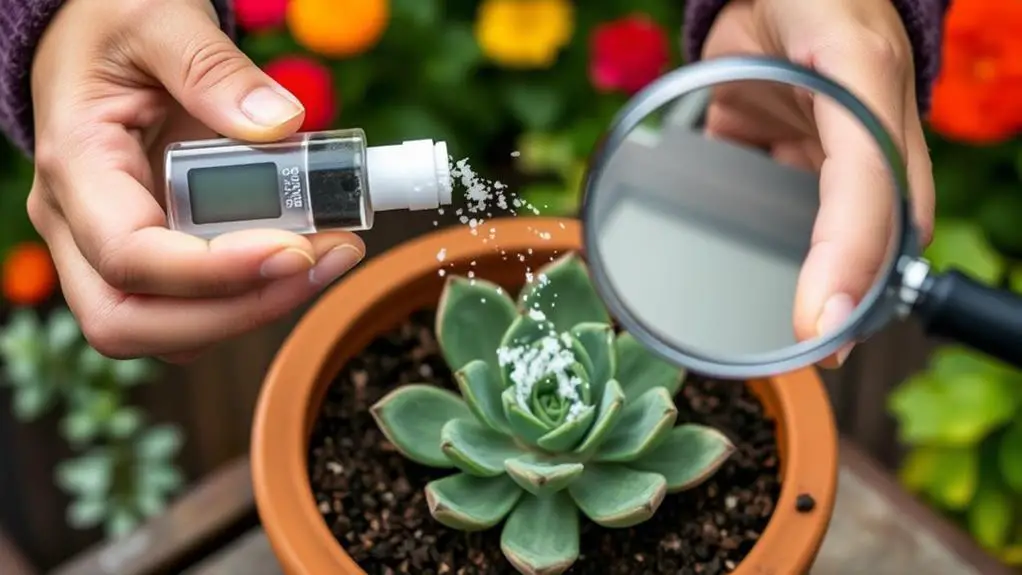
To make sure your succulents are getting enough magnesium, start by testing your soil's magnesium levels.
You can use a soil test kit from a garden center or online to measure not only magnesium but also other nutrients and pH levels.
If your test shows magnesium below 50 ppm, it's time to contemplate using Epsom salt to help your plants thrive.
Assess Current Magnesium Levels
Determining the current magnesium levels in your soil is essential for maintaining healthy succulents.
You'll want to know if your soil has the right amount of magnesium and sulfate to support your plants. Soil testing is a simple way to get this information.
If you notice yellowing leaves, especially in older foliage, it might be a sign of magnesium deficiency. Testing your soil's pH alongside magnesium levels can also help you decide if Epsom salt is needed.
Ideally, your soil should have magnesium levels between 25 to 50 ppm. Regular soil testing every 6 to 12 months will help you monitor these levels and adjust your care routine accordingly for thriving succulents.
Use a Soil Test Kit
When guaranteeing your succulents have the right magnesium levels, using a soil test kit becomes essential.
Start by reading the instructions that come with your kit. You'll usually need to collect soil samples and mix them with a testing solution. Aim for magnesium levels around 50-100 ppm for healthy succulents.
If levels are below this, you might need to add Epsom salt. Don't forget to check the soil pH too; an ideal range is 6.0 to 7.0, which helps your succulents absorb nutrients effectively.
Regular testing helps you track changes and avoid over-fertilization. By using a soil test kit, you can guarantee your succulents get the nutrients they need to thrive.
Interpret Test Results Carefully
Understanding your soil test results is essential for maintaining healthy succulents. When you interpret test results carefully, you can address any magnesium deficiency in your plants. Symptoms like yellowing leaves and stunted growth signal a need to test your soil.
- Use a soil test kit or send samples to a lab for accurate results.
- Check soil pH, as it affects magnesium availability.
- Conduct tests every few months, especially before the growing season.
- Balance Epsom salt application with other fertilizers to avoid nutrient imbalances.
- Adjust care based on test findings to guarantee peak succulent health.
Regular testing and careful interpretation help you provide the best care for your succulents, ensuring they thrive.
Prepare the Solution
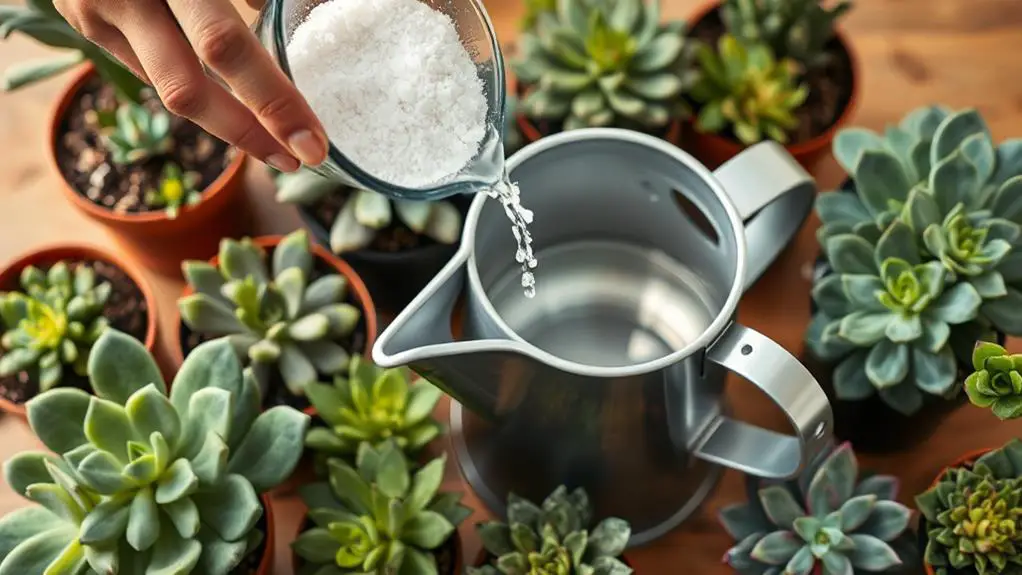
To prepare the Epsom salt solution, dissolve 1 tablespoon of Epsom salt in 1 gallon of warm water. This mixture helps your succulents absorb nutrients effectively.
Use hot water to dissolve the Epsom salt more easily, guaranteeing you get a uniform solution to water your plants with. After mixing, let the solution cool to room temperature. This step is essential to avoid shocking your succulents with sudden temperature changes.
Remember, you should only use this solution every 4-6 weeks during the growing season for the best results.
Before you start, it's wise to test your soil's magnesium levels to see if this solution is necessary. Doing this guarantees your succulents get just the right care.
Apply Monthly
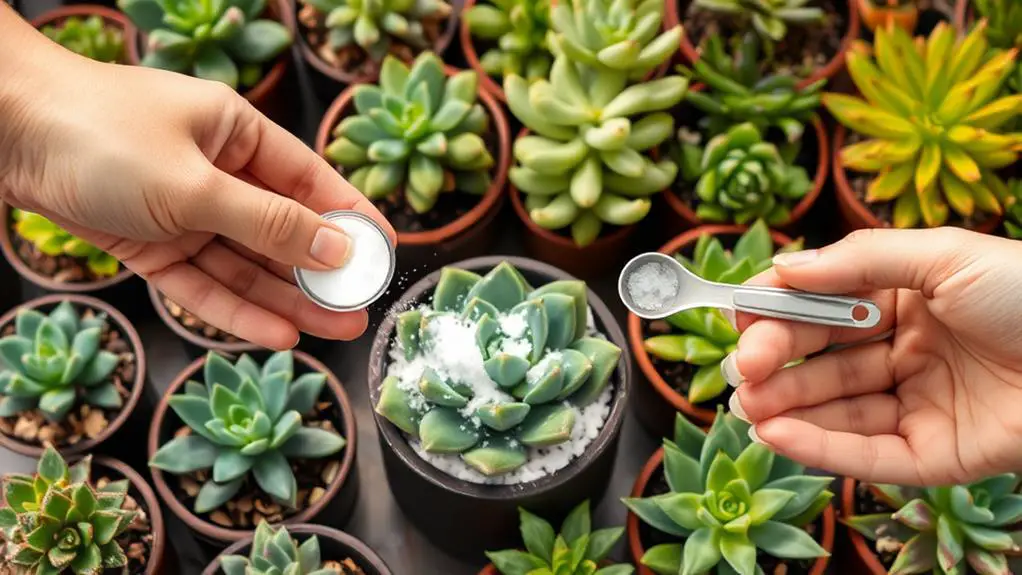
After preparing your Epsom salt solution, it's time to focus on the application process. To guarantee your succulents thrive, apply monthly during the growing season. Using Epsom salt can boost magnesium absorption and promote healthy growth.
Here's how to do it:
- Pour the solution directly onto the soil around the base of your succulents.
- For potted succulents, make sure the soil is well-draining to prevent salt buildup.
- Watch your plants for signs of stress or improvement.
- Adjust the frequency or concentration if needed based on your observations.
- Stick to a monthly schedule to avoid over-fertilizing, which can harm the plants.
Use as Top Dressing

You can effectively use Epsom salt as a top dressing to give your succulents an extra nutrient boost. Sprinkle a light layer of dry Epsom salt around the base of your succulent, but make certain it doesn't touch the leaves to avoid burn. Use about 1 tablespoon per plant, adjusting for size. After applying, water thoroughly to dissolve the salt, guaranteeing it seeps into the soil. Apply this top dressing every 4-6 weeks during the growing season. Always monitor your plant's response and confirm the soil is well-draining to prevent salt buildup and root rot.
| Step | Description |
|---|---|
| 1. | Sprinkle light layer around base |
| 2. | Avoid contact with leaves |
| 3. | Use 1 tablespoon per plant |
| 4. | Water thoroughly after application |
| 5. | Apply every 4-6 weeks |
Mix During Repotting

Repotting your succulents offers an excellent opportunity to enrich their soil with essential nutrients. Mix 1-2 tablespoons of Epsom salt into the soil to boost magnesium levels and promote healthy growth. This simple step can help reduce transplant shock by enhancing nutrient absorption and overall plant health.
Make sure to use well-draining soil to prevent root rot and maintain ideal moisture levels.
Here are some tips to keep in mind:
- Test the soil's magnesium levels before adding Epsom salt.
- Use well-draining soil to avoid waterlogged roots.
- Mix Epsom salt evenly into the soil for best results.
- Monitor your succulent's response after repotting.
- Adjust future Epsom salt applications based on plant health.
Monitor Plant Response

After applying Epsom salt, keep a close watch on your succulents for any signs of stress like yellowing leaves or curling, which could mean you've used too much.
Notice any improvements in growth, leaf size, or color vibrancy within a few weeks.
If you see positive changes but also some stress indicators, adjust how often you use the Epsom salt to find the right balance for your plants.
Signs of Improvement
Paying close attention to your succulents after applying Epsom salt can reveal significant signs of improvement.
You'll start noticing your plants looking healthy and thriving with better color and growth. Here are some key signs to watch for:
- Yellowing leaves: If they return to a healthy green, it means their magnesium levels are improving.
- Increased leaf size and vigor: Larger leaves and a more robust appearance indicate better nutrient absorption.
- Flowering: More blooms suggest that the Epsom salt is promoting flowering.
- Reduced pest activity: Fewer pests show that your succulents are stronger and more resistant.
- Consistent growth: Steady growth patterns are a clear sign your plants are responding well.
These improvements show your succulents are on the right track!
Stress Indicators
While it's exciting to see your succulents flourish with Epsom salt, it's equally important to monitor for any stress indicators.
Start by looking for yellowing leaves, especially older ones, as this might indicate a magnesium deficiency or over-fertilization stress.
Notice if your succulent's leaves are curling or browning at the tips, which can signal stress from too much Epsom salt.
Watch for increased susceptibility to pests and diseases—this could mean a nutrient imbalance.
Also, observe any changes in flower production; reduced blooming might show the plant isn't responding well to the treatment.
Adjust Application Frequency**
Adjusting the frequency of Epsom salt application is essential to maintaining the health of your succulents. Monitor your indoor succulents closely for any signs of stress, like yellowing leaves or curling.
If they show positive responses, such as new growth or vibrant colors, stick with a monthly application frequency. However, if you notice negative effects, reduce it to every 6-8 weeks or stop temporarily.
- Track seasonal changes; succulents need less Epsom salt during dormancy.
- Regularly test soil magnesium levels to avoid over-fertilizing.
- Observe for stress indicators to fine-tune your schedule.
- Adjust based on plant response to guarantee their well-being.
- Keep a journal of changes and results for reference.
Adjust Application Frequency

To achieve the best results for your succulents, you need to adjust the application frequency of Epsom salt based on their growth stage.
During the growing season, apply Epsom salt every 4-6 weeks for ideal benefits. Monitor your succulents closely after each application to identify signs of stress or improvement. This helps you decide if you need to adjust the frequency.
For indoor succulents, reduce the application to once a month since they need less fertilizer than outdoor plants. If you notice yellowing leaves or salt buildup, reduce the frequency to prevent further damage.
During the dormant season, usually in winter, refrain from using Epsom salt, as succulents require minimal fertilization during this time.
Observe for Overuse

In addition to its benefits, overusing Epsom salt can harm your succulents. To keep your plants healthy, you need to observe for overuse carefully. Epsom salt can help, but too much can cause problems.
Look for these warning signs:
- White crust on soil: This indicates salt buildup.
- Yellowing leaves or leaf curling: Signs of over-fertilization and stress.
- Stunted growth or reduced blooming: You might be using Epsom salt too often.
- Root damage: Limit to one tablespoon per gallon of water.
- Magnesium levels: Conduct soil tests periodically.
Frequently Asked Questions
How to Use Epsom Salt for Succulents?
Dissolve 1 tablespoon of Epsom salt in a gallon of water and apply monthly during the growing season. Alternatively, sprinkle a small amount around the plant base or mix into potting soil when repotting to boost magnesium levels.
Can I Sprinkle Epsom Salt Around Plants?
Yes, you can sprinkle Epsom salt around plants. Use about 1 tablespoon per plant, applying it evenly at the base. It provides essential magnesium and sulfate but don't overdo it to avoid soil salt buildup.
What Happens if You Put Too Much Epsom Salt on Plants?
If you put too much Epsom salt on plants, you'll risk root damage and hinder their ability to absorb water and nutrients. Watch for yellowing leaves, curling, and browning tips, which indicate stress from high salt concentrations.
How Do You Use Epsom Salt for Money Plants?
Dissolve 1 tablespoon of Epsom salt in a gallon of water and use it to water your money plants every 4-6 weeks. Make certain you monitor for signs of stress and check soil magnesium levels regularly.
Conclusion
You've got everything you need to help your succulents thrive with Epsom salt. Start by understanding the benefits and testing your soil. Prepare the solution, apply it monthly, and mix it in when repotting. Keep an eye on your plants and adjust as needed. It's all about finding the right balance. With these steps, you'll see healthier, happier succulents in no time. You're on your way to becoming a succulent pro—happy gardening!

